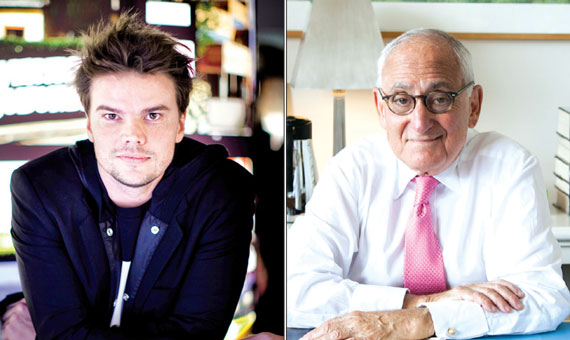Trending
Beyond blueprints
New tomes, by Bjarke Ingels and Robert A.M. Stern, highlight the starchitects’ </br>very different approaches

Sometimes, you can judge books by their covers. Two recent tomes from architects enjoying a moment in the New York sun show, from their very book jackets, the contrasts between them and their work.
“Hot to Cold,” by Danish star Bjarke Ingels, is a rainbow-hued exploration of recent work by the firm that bears his initials, BIG, including the Durst “pyramid” at 625 West 57th Street and his “Dry Line,” the U-shaped flood mitigation project he envisions for Manhattan.
In contrast, “Robert A.M. Stern Architects: Buildings and Projects 2010-2014” wears a sedate Federal blue cover bearing a small photograph of an entryway that reflects the classically inspired designs the New York-based elder statesman is known for, including 30 Park Place and the Abington House on the High Line.
Yet even though the two books highlight the disparities, they also showcase a similar thoughtfulness and careful approach the two firms take to their works around the world, as they design projects intended to fit into their surroundings, reflecting a sense of the culture and space they inhabit.
“Hot to Cold” spans the globe with an approach that incorporates the temperature of the locations into the order they are arranged.
“We have organized this book according to climate, like an odyssey across the globe from one of the hottest places on the planet, the Arabian desert, to one of the coldest, the Finnish tundra,” Ingels explains in his introduction.
Each of the 57 projects depicted is used to explain his philosophy of incorporating the surrounding environment into his designs. It starts with the proposal for a “Middle Eastern Media HQ” presumably a new headquarters for Al Jazeera, in Doha, Qatar. The structure, dubbed the “Magic Carpet,” is designed to mimic the rugs and tapestries used by the residents of the Middle East to shade outdoor spaces and make them habitable in the extreme heat. The flowing design evokes Ingels’ signature even to an untrained eye, with a vast canopy that appears to hang between two towers. The pages that follow show various elevations and interior renderings of the buildings, demonstrating how the buildings’ inhabitants would use it, and offer a narrative of the thinking behind the design elements.
In the section on the 57th Street pyramid, which Ingels calls the “Courtscraper,” (a combination of “courtyard” and “skyscraper”) the reader is treated to a brief description of the architect’s first meeting with Douglas Durst, which took place at a sustainable design conference in Copenhagen, Denmark, where the developer was speaking.
“I was very impressed with Durst’s smart, funny and surprisingly humble presentation of all the efforts put into making the buildings as sustainable as possible. But somehow, it seemed like purely technical upgrades, as if the actual design of the buildings was just business as usual, and then builders and engineers would install sophisticated environmental machinery,” Ingels wrote. He wanted to ask if they considered using the intended function of the building to inform the design. His question came out, “Why do all of your buildings look like buildings?”
From that moment, “three years of conversation followed,” and eventually, Durst sent him a note regarding “a small project in Hell’s Kitchen.”
The drawings of the unique building’s conceptualization are fascinating. “What happens when you combine the density of the Manhattan skyscraper with the communal space of the Copenhagen courtyard?” Ingels asks, then proceeds to illustrate. He envisions the central space to serve a similar function for the inhabitants of the building as Central Park does for Manhattan on the whole, and notes that the courtyard’s dimensions mimic the park’s, “just 13,000 times smaller.”
The approach taken by Stern’s firm is, on the surface at least, as different as the buildings that result. “Our search continues for an architecture that succeeds by virtue of its ability to connect; to be inventive yet somehow familiar; to be present but not obtrusive; to be the setting, and not the performance, in the drama of daily life,” Stern writes in the introduction.
The book, seventh in a series highlighting the firm’s work, also serves to highlight its international expansion, featuring works from a French villa to a residential complex in Astana, Kazakhstan. And while Stern’s residential work gets the most attention locally, the book also includes a number of the firm’s academic buildings and the George W. Bush Presidential Center in Dallas.
Each entry in the oversized book features sumptuous photos and renderings, with various views of the projects’ exteriors and interiors. They are accompanied by only short explanations of the designs, leaving the images to largely speak for themselves, visually inviting the reader into the spaces.
One striking entry is “Heart of Lake,” a massive residential complex in Xiamen, China, an historic port, where construction started in 2012. The buildings, which vary from high-rise apartment towers to individual townhouses, are clad with local yellow granite and surrounded by walkways and a park. The designs at once evoke a European style and a Chinese spirit, with archways, tile work and rooflines that give the development a distinctly Asian feel.
A dozen New York projects are also included in the book, including 520 Park Avenue, the latest project Stern is handling for Zeckendorf Development, for whom the firm designed the smashingly successful 15 Central Park West. In addition to the now-familiar skyline rendering of the tower, several pages of interior designs treat the eye to the luxurious project in the works.
“Hot to Cold” is published by Taschen Books. “Buildings and Projects” is published by the Monacelli Press.




